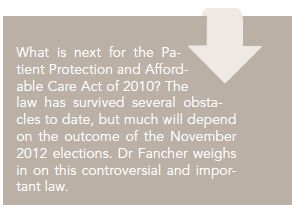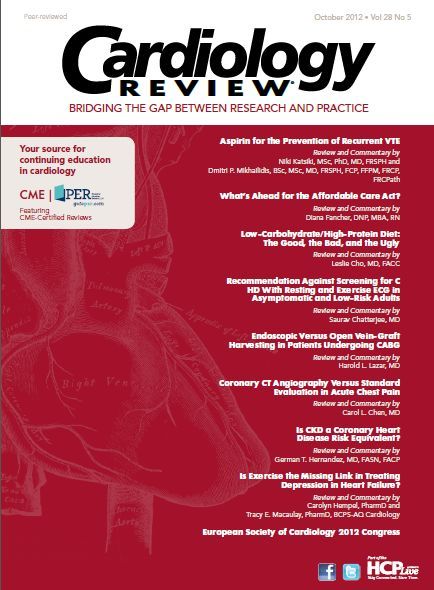Publication
Article
Cardiology Review® Online
What's Ahead for the Affordable Care Act?

Diana Fancher, DNP, MBA, RN
Review
McDonough, JF. The road ahead for the Affordable Care Act. N Engl J Med. 2012;367:
199-201.

In his commentary, “The Road Ahead for the Affordable Care Act,” published in The New England Journal of Medicine, John E. Mc- Donough, DrPH, of the Department of Health Policy and Management at the Harvard School of Public Health, offers his perspective on the obstacles that have faced the Patient Protection and Affordable Care Act (ACA) and the remaining threats to its complete implementation, including the approaching November 6, 2012, presidential and Congressional elections.1
The ACA, Dr McDonough writes, overcame a series of hurdles, the most dramatic of which was the election of Massachusetts Republican Scott Brown to the US Senate, reducing the Democrats’ 60-vote Senate majority and leaving political followers and ACA supporters concerned about the future of comprehensive health care reform.
The March 2012 oral arguments of the Supreme Court justices suggested that 4 of the 9 justices wanted to overturn the ACA, bringing home to many analysts the realization that the stakes were indeed much higher than previously thought. Even with the US Supreme Court’s 5-to-4 vote upholding the health care reform plan as
constitutional on June 28, 2012, the Act faces another “mortal challenge,”

Dr McDonough states, with the November 2012 elections. There is much at stake for the ACA in the upcoming elections. The ACA will be implemented if the Democrats maintain the White House and Senate and regain control of the House; if Republicans are voted into the White House and Senate and maintain a majority in the House, health care reform will encounter major overhauls and disassembling in 2013. If the elections result in a split between the parties, conflict will persist. Dr McDonough notes that the November elections are increasingly feeling like a referendum on the ACA.
The Supreme Court’s ruling did result in some changes, but implementation continues to roll out—until the ACA meets potential future, insurmountable obstacles. The ACA’s provisions mandating that individuals obtain insurance coverage, the elimination of exclusions for preexisting conditions, the development of state health exchanges, and private insurance subsidies remain intact. The protection of millions of Americans now benefiting from the already-implemented provisions of the ACA is one positive outcome of the Court’s June ruling. The 6 million young adults now eligible to be enrolled in their parents’ insurance plan and the 5 million- plus Medicare beneficiaries with reduced prescription expenses are 2 groups exemplifying current recipients of an improved health environment
through already implemented reform.
A significant change following the Court’s ruling, however, is related to the expansion of Medicaid. The ACA of 2010 obligated Medicaid to serve a majority of legal residents with incomes below 138% of the federal poverty level. Currently, states will not lose federal funding if they choose not to expand their Medicaid programs.
Governors making the choice not to participate in Medicaid expansion will create a new inequity in health care by 2014 by excluding populations that fall into a non-covered category for insurance coverage—populations the ACA is targeting. The individual state and governors’ decisions to participate in Medicaid expansion will become more obvious following the November 6 election, when the highly politicized pre-election environment dissipates. There is a strong financial incentive for states to participate in Medicaid expansion, tempered by fears of the unknown number of currently eligible people who will sign up for Medicaid. With larger federal match dollars not scheduled until 2014, the current lower federal match dollars for Medicaid will further burden states’ already lean budgets if there is a large spike in Medicaid enrollments. In addition, states must decide whether to launch health insurance exchanges in the near future, and demonstrate sufficient progress to that end by January 2013. Currently the Obama administration continues to implement the “underappreciated” (in Dr McDonough’s words), complex, and multifaceted ACA. Pending milestones still to be executed include writing definitions and rules, clarifying “essential health benefits,” and explaining employer responsibility provisions. There remains a great deal of work to be completed. Dr McDonough points out that President Lyndon Johnson’s achievement in establishing Medicare and Medicaid in 1965 was more narrowly focused than the ACA, leaving the ACA as the first US law to attempt such comprehensive and systemic health care delivery reform. In a less hostile pre-election political environment, both sides of the political aisle would be working together to assess, modify, and rework elements of the ACA. To paraphrase Dr McDonough, “Perhaps we will still get there, but there are still many obstacles ahead.”
References
1. McDonough, JF. The road ahead for the Affordable Care Act. N Engl J Med. 2012;367:199-201.
2. The 2010 Patient Protection and Affordable Care Act [HR3590]. http://www.gpo.gov/ fdsys /pkg/PLAW-111publ148/pdf/PLAW-111publ148.pdf.
3. Kale MS, Federman AD, Ross JS. Visits for primary care services to primary care and specialty care physicians, 1999 and 2007 [research letter]. Arch Intern Med.
2012. Published online August 20, 2012.
It is my opinion that the Patient Protection and Affordable Care Act of 2010 has been crafted with the positive intent of reforming the health care delivery system and expanding medical care through a multitude of complex transformations. This reform was designed to reach vulnerable populations, as well as to revise the health care system through the development of a more efficient and cost-effective roadmap for all patients navigating the continuum of the health care landscape. The ACA contains 9 Titles, with each Title encompassing a wide range of reforms arising from different aspects within health care delivery.2 The election results may deliver the same executive and national leadership and implementation will remain intact, although the opportunity for interpretation and revisions of the ACA will remain as new Democrats and Republicans are seated, and power and agendas shift with each coming election over the next several years.
The outcomes of the November elections will largely determine the scope and depth of health care reform that will be experienced in the United States over the next 5 years. The states choosing not to participate in Medicaid expansion will leave many citizens vulnerable and without access to quality health care. The health care system today is fraught with inefficiencies, redundancies, poor accessibility, and overutilization. Title I of the ACA mandates quality, affordable health care for all Americans. The ACA embraces this mandate by addressing and prioritizing these issues through the development of more accessible, efficient systems, an increase in the number of health care providers, and expanding insurance coverage to more Americans.
A recent study3 published by the American Medical Association found that less than two-thirds of outpatients accessed primary care physicians for their primary care services. This percentage remained essentially unchanged between the years of 1999 and 2007 and is a reflection of inefficiency in the health care system and the overutilization of resources. However, is the current number of primary care providers large enough to absorb the 40% of patients now seeing specialists
if the ACA evolves to limit patients’ access to specialists as a byproduct of more efficient resource management?
Commentay
An Unsustainable Status Quo
The ACA specifically addresses the inadequate numbers of primary care providers in the workforce by encouraging innovations in health care workforce training, recruitment, and retention, the establishment of a new workforce commission, and strengthening primary care through grants, reallocating unfilled residency positions to teach primary care physicians, and new models for teaching advanced-practice nurses. The creation of health care work development strategies will be of paramount importance as coverage expands and the ability to access primary care rapidly increases. Nonetheless, the development of a larger health care workforce will likely lag with respect to the time frames projected for the implementation of the ACA. Therefore, following the November 6 elections newly formed political alliances and elected officials who choose to begin disassembling the ACA must take into consideration the complexity and interrelated objectives that will be involved in the
decision-making process.
Title III of the ACA was written to address efficiency and quality outcomes in medical care and the health delivery system. Accountable Care Organizations (ACOs) are an important element in transforming the health care delivery system from the common fee-for-service model to an outcome-driven delivery system that addresses the needs of the patient through the continuum of services, including education and prevention. The goal of the ACOs will be to deliver patient-centered health care in a seamless continuum, reducing fragmentation and rewarding quality. Organizations able to demonstrate the ability to take responsibility for the cost and quality of care will receive a share of the savings achieved for Medicare.
The ACA is projected to cost upwards of $1 trillion, without a clear plan for financing the objectives. Many rightfully fear the funding of this plan will be through higher taxes—resulting in less disposable income for household spending—and anticipate fines for not participating in an insurance plan. Transformational development of seamless health care systems, the elimination of duplication and fragmentation, and rewarding cost containment and quality will offset some of this cost.

There is a value in creating a healthier nation, with an emphasis on prevention, education, and the proper utilization of health care resources. Sweeping reform will have to occur if basic health care is to be extended to most US citizens to include addressing the current disparities and gaps in health care delivery in a comprehensive
manner. Regardless of which side of the aisle politicians are on, the need for expanding coverage and systemic reform must occur, because the status quo is simply not sustainable.
As the ACA is scrutinized and changed in the near future, politicians and citizens must come to some agreement as to how it develops further. The November 6 election will determine the future course for the nation’s health care journey. There seems to be a greater consensus among Americans in 2012 than there was in 1993
(the last time the issue was addressed by Congress and the president) that the US health care delivery system is broken. While the opinion about how best to “fix” the system is not shared by all, it is my judgment that the ACA, an extensive roadmap that accounts for all facets of health delivery, correctly seeks to move away from the payment-forservice model. Using this plan as a weapon in a political fight will only serve to delay an overdue change in the health care system.
About the Author
Diana Fancher, DNP, MBA, RN , is Chief Nursing Officer at the University Medical Center of El Paso in El Paso, TX, where she administers, directs, and coordinates patient care services and operations in this 394-bed acute care facility/Level 1 trauma center/academic teaching hospital. Dr Fancher has over 19 years of experience in health care and is a member of the hospital’s senior executive team in planning, policy formation, strategic decisions, and implementation, and is directly responsible for
an $85 million operational budget and $2 million capital budget.
